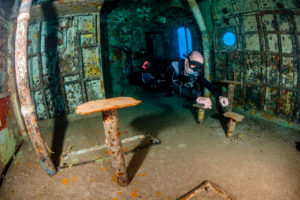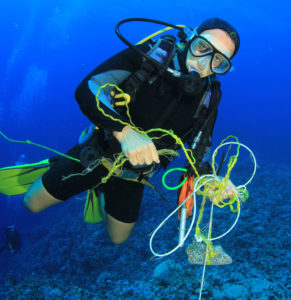People wreck dive for many reasons, whether to see the resident marine life or a part of history right in front of them. Either way, wreck diving can be some of the best diving you’ll ever do. But as alluring as they are, wrecks can be very dangerous places. Don’t even entertain the idea of wreck penetration without the proper training. Even then, there are hazards to consider when it comes to wreck penetration. Here are three main ones to watch out for.
Becoming lost or disoriented
Wrecks tend to gather layers and layers of silt, just waiting for a diver to come along and kick them up. Doing so can reduce visibility to zero — and we do mean zero — in a matter of seconds. The silt can take a long time to settle — time you won’t have on an open-circuit scuba unit.
 Ships can be confusing places. I tell my students to imagine visiting a ship in a maritime museum. Go inside, descend a few flights of stairs, and walk along the corridors until you find a room. Now cover your eyes, spin around a few times and feel your way out. You’ll get out of the ship eventually, but it will take a long time and you’ll probably have a few bruises on your head and shins. Now imagine the same scenario underwater, but remember that you have a finite amount of gas and the ship may be on its side or upside down.
Ships can be confusing places. I tell my students to imagine visiting a ship in a maritime museum. Go inside, descend a few flights of stairs, and walk along the corridors until you find a room. Now cover your eyes, spin around a few times and feel your way out. You’ll get out of the ship eventually, but it will take a long time and you’ll probably have a few bruises on your head and shins. Now imagine the same scenario underwater, but remember that you have a finite amount of gas and the ship may be on its side or upside down.
If you bang your head, you could knock yourself unconscious or begin bleeding. As you move along, you may be going deeper into the wreck. You could also get entangled or entrapped at any point. Buoyancy is harder to maintain, and it will be challenging to avoid scraping your equipment, banging your tank valve, or accidentally puncturing your BC.
Preventing disorientation
Wreck divers learn how to use a guideline; how to lay it correctly; how to utilize it properly; and how to avoid coming into contact with it. They also spend a lot of time learning different propulsion methods and honing their buoyancy to minimize kicking up silt. Crucially, they also learn when to avoid entering an area that looks too silty. Getting to know a wreck very well before even thinking of going inside is very important.
Becoming entangled
 Wrecks are often covered in fishing nets and line, which can easily tangle you up. Monofilament fishing line is especially difficult to see. Inside a wreck, electrical wiring can be a huge problem. Trunking that holds the wires will degrade over time and wires will spill out and fill a room like a spider’s web. Entanglement on either your own or a previously laid guideline is another potential hazard. It may seem almost like these things exist solely to ensnare you as much as possible.
Wrecks are often covered in fishing nets and line, which can easily tangle you up. Monofilament fishing line is especially difficult to see. Inside a wreck, electrical wiring can be a huge problem. Trunking that holds the wires will degrade over time and wires will spill out and fill a room like a spider’s web. Entanglement on either your own or a previously laid guideline is another potential hazard. It may seem almost like these things exist solely to ensnare you as much as possible.
Preventing entanglement
Carry a suitable, well-maintained cutting device and store it in an easily accessible spot. Do not thrash wildly if you become entangled, and stay calm. Again, developing good awareness of any dangers and simply avoiding them is the best technique you can employ.
Becoming entrapped
Becoming entrapped is every diver’s worst nightmare. Wrecks, made of wood and metal, weaken over time and become unstable. Doors or hatches may close behind you and be impossible to reopen. Ceilings and other items may collapse on top of you.
Preventing entrapment
Knowing the wreck from a combination of blueprints and previous orientation dives, having good awareness, and being very cautious when entering any room are the best forms of defense here. Use reliable techniques to tie hatches and doors open, and buddy teams must have a common set of procedures for removing them when exiting the wreck. Reconnaissance, caution, and sticking to your dive plan completely are the best ways to reduce your risk. Do not be tempted to explore an unknown corridor.
Other hazards
Numerous other hazards include sharp objects, unexploded ordnance, inadequate gas management, narcosis, increased depth, equipment failure and unsuitability, weather changes during a dive, anxiety and panic, losing your buddy, and losing the guideline. In short, there is a lot to consider when considering wreck penetration. Anywhere with an overhead environment, preventing direct access to the surface, presents a hazard to a diver.
One final hazard to note is potentially your buddy or dive guide. If you do not have suitable wreck qualification and your buddy or guide wants to take you into a wreck, do not follow them. Many people have died inside wrecks because they or their buddy got arrogant or didn’t take the hazards of wreck penetration seriously. Don’t be one of them, and don’t rely on someone else’s ability to take care of you when they don’t really understand what they are doing themselves.
Seek proper training and practice regularly
There are numerous diving techniques and planning tools you must learn to become a competent wreck diver. To be sure that you’re learning effective techniques, seek training from an instructor with a background in wreck diving. Most technical diving instructors will have an advanced wreck qualification, which is equivalent to a qualification in cave diving. This allows divers to go beyond the daylight zone in a wreck. Training doesn’t end the learning process, however. You must practice what you’ve learned with similarly qualified divers — that’s where the fun really begins.
Maintaining a healthy appreciation for the dangers of wreck penetration can only help you stay safer. PADI and SDI offer wreck specialty courses that allow limited penetration. TDI provides advanced wreck training.
Once you have undertaken training, there are literally thousands of wrecks to explore all around the world. So, what are you waiting for?

